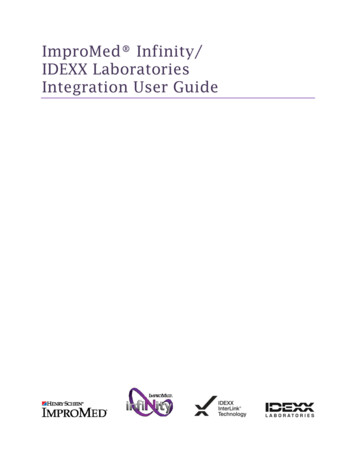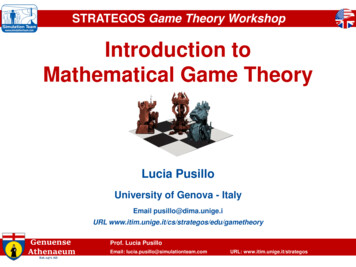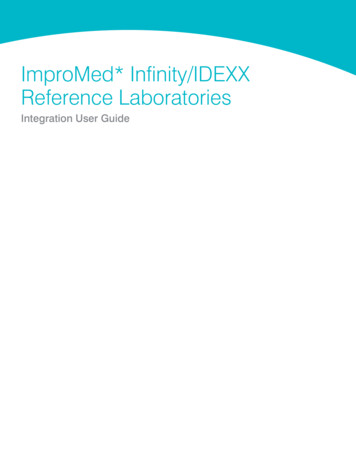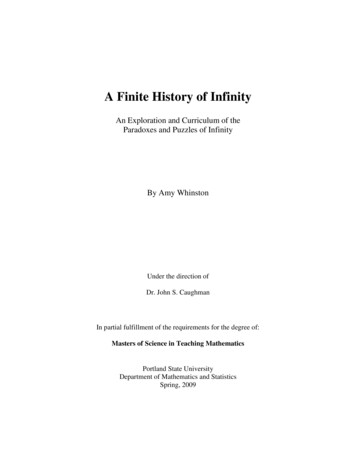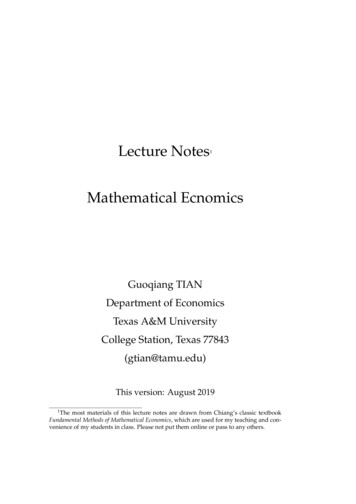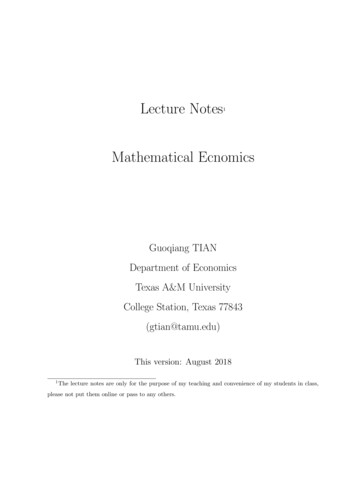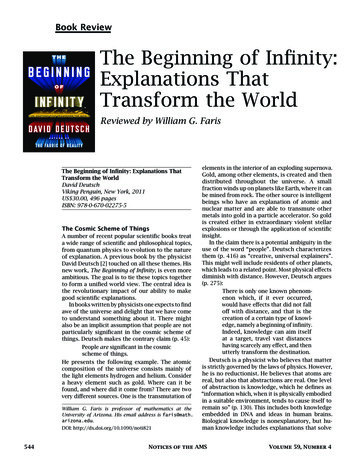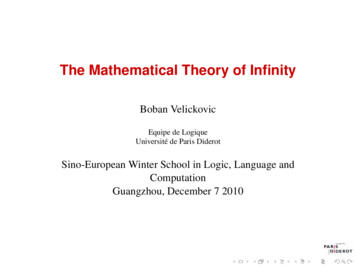
Transcription
The Mathematical Theory of InfinityBoban VelickovicEquipe de LogiqueUniversité de Paris DiderotSino-European Winter School in Logic, Language andComputationGuangzhou, December 7 2010
Outline1Introduction2A brief history of infinity3The work of Cantor4Undecidable Problems
Outline1Introduction2A brief history of infinity3The work of Cantor4Undecidable Problems
IntroductionInfinity : without a doubt, one of the strangest, richest and even mostdangerous notions humanity has invented.From Antiquity philosophers realized that it leads to puzzlingparadoxes.Cosmologists wondered about the physical Universe, and especiallysince Einstein’s relativity theory. Is the Universe finite or infinite ?Will it last indefinitely ?Artists saw in it an inexhaustible source of inspiration.Theologians saw in it an attribute of God and even forbade to speakabout it.
IntroductionInfinity : without a doubt, one of the strangest, richest and even mostdangerous notions humanity has invented.From Antiquity philosophers realized that it leads to puzzlingparadoxes.Cosmologists wondered about the physical Universe, and especiallysince Einstein’s relativity theory. Is the Universe finite or infinite ?Will it last indefinitely ?Artists saw in it an inexhaustible source of inspiration.Theologians saw in it an attribute of God and even forbade to speakabout it.
IntroductionInfinity : without a doubt, one of the strangest, richest and even mostdangerous notions humanity has invented.From Antiquity philosophers realized that it leads to puzzlingparadoxes.Cosmologists wondered about the physical Universe, and especiallysince Einstein’s relativity theory. Is the Universe finite or infinite ?Will it last indefinitely ?Artists saw in it an inexhaustible source of inspiration.Theologians saw in it an attribute of God and even forbade to speakabout it.
IntroductionInfinity : without a doubt, one of the strangest, richest and even mostdangerous notions humanity has invented.From Antiquity philosophers realized that it leads to puzzlingparadoxes.Cosmologists wondered about the physical Universe, and especiallysince Einstein’s relativity theory. Is the Universe finite or infinite ?Will it last indefinitely ?Artists saw in it an inexhaustible source of inspiration.Theologians saw in it an attribute of God and even forbade to speakabout it.
IntroductionInfinity : without a doubt, one of the strangest, richest and even mostdangerous notions humanity has invented.From Antiquity philosophers realized that it leads to puzzlingparadoxes.Cosmologists wondered about the physical Universe, and especiallysince Einstein’s relativity theory. Is the Universe finite or infinite ?Will it last indefinitely ?Artists saw in it an inexhaustible source of inspiration.Theologians saw in it an attribute of God and even forbade to speakabout it.
Numerous mathematicians refused to admit the existence of infinityin mathematics. Recent developments proved them wrong. Even if weare interested in the simplest mathematical objects, natural numbers,in order to resolve certain questions about them requires the use ofinfinity.Infinity stirs passions, quarrels and even fratricidal wars betweenmathematicians. Sometimes, it leads to insanity its own inventors.
Numerous mathematicians refused to admit the existence of infinityin mathematics. Recent developments proved them wrong. Even if weare interested in the simplest mathematical objects, natural numbers,in order to resolve certain questions about them requires the use ofinfinity.Infinity stirs passions, quarrels and even fratricidal wars betweenmathematicians. Sometimes, it leads to insanity its own inventors.
Outline1Introduction2A brief history of infinity3The work of Cantor4Undecidable Problems
A brief history of infinityZeno of Elea (born 495 B.C., died around 430 B.C.), follower ofParmenides. Stated several paradoxes concerning motion and thenature of infinity.
Paradox of Achilles and the TortoiseA race between Achilles and the Tortoise.The Tortoise starts with 1 km advantage.Achilles runs twice as fast as the Tortoise.A the moment Achilles reaches the point where the Tortoise was,the Tortoise has advanced a certain distance.Every time Achilles passes by the point where the Tortoise was,the Tortoise progresses.Achilles will never reach the Tortoise !
Paradox of Achilles and the TortoiseA race between Achilles and the Tortoise.The Tortoise starts with 1 km advantage.Achilles runs twice as fast as the Tortoise.A the moment Achilles reaches the point where the Tortoise was,the Tortoise has advanced a certain distance.Every time Achilles passes by the point where the Tortoise was,the Tortoise progresses.Achilles will never reach the Tortoise !
Paradox of Achilles and the TortoiseA race between Achilles and the Tortoise.The Tortoise starts with 1 km advantage.Achilles runs twice as fast as the Tortoise.A the moment Achilles reaches the point where the Tortoise was,the Tortoise has advanced a certain distance.Every time Achilles passes by the point where the Tortoise was,the Tortoise progresses.Achilles will never reach the Tortoise !
Paradox of Achilles and the TortoiseA race between Achilles and the Tortoise.The Tortoise starts with 1 km advantage.Achilles runs twice as fast as the Tortoise.A the moment Achilles reaches the point where the Tortoise was,the Tortoise has advanced a certain distance.Every time Achilles passes by the point where the Tortoise was,the Tortoise progresses.Achilles will never reach the Tortoise !
Paradox of Achilles and the TortoiseA race between Achilles and the Tortoise.The Tortoise starts with 1 km advantage.Achilles runs twice as fast as the Tortoise.A the moment Achilles reaches the point where the Tortoise was,the Tortoise has advanced a certain distance.Every time Achilles passes by the point where the Tortoise was,the Tortoise progresses.Achilles will never reach the Tortoise !
Paradox of Achilles and the TortoiseA race between Achilles and the Tortoise.The Tortoise starts with 1 km advantage.Achilles runs twice as fast as the Tortoise.A the moment Achilles reaches the point where the Tortoise was,the Tortoise has advanced a certain distance.Every time Achilles passes by the point where the Tortoise was,the Tortoise progresses.Achilles will never reach the Tortoise !
Paradox of Achilles and the TortoiseIt took humanity around 20 centuries to properly resolve this paradox !
Paradox of Achilles and the TortoiseIt took humanity around 20 centuries to properly resolve this paradox !
Galileo GalileiGalileo (1564 1642) notices that there are equally many naturalnumbers and perfect squares squares of natural numbers since one canmake a 1 correspondence between them, to 1 we associate 1, to 2 weassociate 4 22 , to 3 we assign 9 32 , etc. On the other hand, the setof squares of natural numbers is properly contained in the set of allnatural numbers.
Galileo GalileiGalileo (1564 1642) notices that there are equally many naturalnumbers and perfect squares squares of natural numbers since one canmake a 1 correspondence between them, to 1 we associate 1, to 2 weassociate 4 22 , to 3 we assign 9 32 , etc. On the other hand, the setof squares of natural numbers is properly contained in the set of allnatural numbers.
Hilbert’s hotelWe imagine a hotel with infinitely many rooms which are alloccupied.A new guest arrives ; we move guest from room 1 to room 2,guest from room 2 to room 3, etc. Room 1 is now vacant and wecan put in it the new guest.Infinitely many new guests arrive ; we put guest 1 to room 2,guest 2 to room 4, guest 3 to room 6, etc. The odd number roomsare now vacant and we can accommodate the new guests.
Hilbert’s hotelWe imagine a hotel with infinitely many rooms which are alloccupied.A new guest arrives ; we move guest from room 1 to room 2,guest from room 2 to room 3, etc. Room 1 is now vacant and wecan put in it the new guest.Infinitely many new guests arrive ; we put guest 1 to room 2,guest 2 to room 4, guest 3 to room 6, etc. The odd number roomsare now vacant and we can accommodate the new guests.
Hilbert’s hotelWe imagine a hotel with infinitely many rooms which are alloccupied.A new guest arrives ; we move guest from room 1 to room 2,guest from room 2 to room 3, etc. Room 1 is now vacant and wecan put in it the new guest.Infinitely many new guests arrive ; we put guest 1 to room 2,guest 2 to room 4, guest 3 to room 6, etc. The odd number roomsare now vacant and we can accommodate the new guests.
Hilbert’s hotelWe imagine a hotel with infinitely many rooms which are alloccupied.A new guest arrives ; we move guest from room 1 to room 2,guest from room 2 to room 3, etc. Room 1 is now vacant and wecan put in it the new guest.Infinitely many new guests arrive ; we put guest 1 to room 2,guest 2 to room 4, guest 3 to room 6, etc. The odd number roomsare now vacant and we can accommodate the new guests.
Outline1Introduction2A brief history of infinity3The work of Cantor4Undecidable Problems
Travaux de CantorIn the second part of the XIX century a German mathematicianGeorg Cantor laid the foundation of set theory. He defined cardinaland ordinal numbers and studied their arithmetic.
Travaux de CantorIn the second part of the XIX century a German mathematicianGeorg Cantor laid the foundation of set theory. He defined cardinaland ordinal numbers and studied their arithmetic.
Cantor’s work provoked many controversies.
DefinitionGiven two sets X et Y , we write X Y if there exists an injectionfrom X to Y . We X Y if there exists a bijection between X and Y .
Theoreme (Cantor - Bernstein)Suppose X Y and Y X. Then X Y .PropositionX is infinite iff X X {x}, for any x X.DefinitionX is countable if X N.
Theoreme (Cantor - Bernstein)Suppose X Y and Y X. Then X Y .PropositionX is infinite iff X X {x}, for any x X.DefinitionX is countable if X N.
Theoreme (Cantor - Bernstein)Suppose X Y and Y X. Then X Y .PropositionX is infinite iff X X {x}, for any x X.DefinitionX is countable if X N.
Theoreme (Cantor)The set of rational numbers Q is countable.Proof :
RemarkIn a similar way we can show that if An is countable, for all n, then n An is countable as well. In fact, An A, for all infinite sets A andintegers n 1.However, there exist sets which are not countable.Theoreme (Cantor)The set of real numbers R is uncountable.
RemarkIn a similar way we can show that if An is countable, for all n, then n An is countable as well. In fact, An A, for all infinite sets A andintegers n 1.However, there exist sets which are not countable.Theoreme (Cantor)The set of real numbers R is uncountable.
RemarkIn a similar way we can show that if An is countable, for all n, then n An is countable as well. In fact, An A, for all infinite sets A andintegers n 1.However, there exist sets which are not countable.Theoreme (Cantor)The set of real numbers R is uncountable.
Proof :We consider a countable subset of [0, 1] enumerated in a seqeuncer (r1 , r2 , r3 , . . .). Each term of this sequence has infinitely manydecimal digits after the ’comma’. We construct a new real number xin [0, 1] by changing the n-th digit after the comma in rn .We see that x rn , for all n. Therefore [0, 1] is not countable.
The French schoolCantor’s discoveries led three French mathematicians Emile Borel,Henri Lebesgue and René Baire to develop the theory of functions,and in particular the Lebesgue integral, which is the foundation offunctional analysis.
Outline1Introduction2A brief history of infinity3The work of Cantor4Undecidable Problems
The Continuum HypothesisThe Continuum Hypothesis (CH)If X is an infinite set of reals numbers then either X N or X R.Cantor worked on this problem for the rest of his life withoutresolving it.It was the first on the famous list of 23 open problems which Hilbertproposed at the International Congress of Mathematicians in Paris in1900.
The Continuum HypothesisThe Continuum Hypothesis (CH)If X is an infinite set of reals numbers then either X N or X R.Cantor worked on this problem for the rest of his life withoutresolving it.It was the first on the famous list of 23 open problems which Hilbertproposed at the International Congress of Mathematicians in Paris in1900.
The Continuum HypothesisThe Continuum Hypothesis (CH)If X is an infinite set of reals numbers then either X N or X R.Cantor worked on this problem for the rest of his life withoutresolving it.It was the first on the famous list of 23 open problems which Hilbertproposed at the International Congress of Mathematicians in Paris in1900.
The foundational crisis of mathematicsAt the end of the XIX century and the beginning of the XX centurymathematics is undergoing a deep foundational crisis provoked by thediscovery of several logical paradoxes.Russell’s ParadoxLet X be the set of all sets x such that x x. ThenX X if and only if X X !Berry’s ParadoxLet n be the least integer not describable by a statement of at mosttwenty words. We just described n by a statement of at most twentywords !
The foundational crisis of mathematicsAt the end of the XIX century and the beginning of the XX centurymathematics is undergoing a deep foundational crisis provoked by thediscovery of several logical paradoxes.Russell’s ParadoxLet X be the set of all sets x such that x x. ThenX X if and only if X X !Berry’s ParadoxLet n be the least integer not describable by a statement of at mosttwenty words. We just described n by a statement of at most twentywords !
The foundational crisis of mathematicsAt the end of the XIX century and the beginning of the XX centurymathematics is undergoing a deep foundational crisis provoked by thediscovery of several logical paradoxes.Russell’s ParadoxLet X be the set of all sets x such that x x. ThenX X if and only if X X !Berry’s ParadoxLet n be the least integer not describable by a statement of at mosttwenty words. We just described n by a statement of at most twentywords !
The logicians try to formalize mathematics on solid grounds.Among the systems proposed, the theory of Zermelo Fraenkeltogether with the Axiom of Choice, ZFC, chronologically one of thefirst, remains the most commonly accepted foundations ofmathematics in the XXI century. The logicians have showed that all ofmathematics can be developed in ZFC. Therefore, the questionbecomes.QuestionDoes the theory ZFC decide the Continuum Hypothesis ?
The logicians try to formalize mathematics on solid grounds.Among the systems proposed, the theory of Zermelo Fraenkeltogether with the Axiom of Choice, ZFC, chronologically one of thefirst, remains the most commonly accepted foundations ofmathematics in the XXI century. The logicians have showed that all ofmathematics can be developed in ZFC. Therefore, the questionbecomes.QuestionDoes the theory ZFC decide the Continuum Hypothesis ?
The logicians try to formalize mathematics on solid grounds.Among the systems proposed, the theory of Zermelo Fraenkeltogether with the Axiom of Choice, ZFC, chronologically one of thefirst, remains the most commonly accepted foundations ofmathematics in the XXI century. The logicians have showed that all ofmathematics can be developed in ZFC. Therefore, the questionbecomes.QuestionDoes the theory ZFC decide the Continuum Hypothesis ?
Consistency of the Continuum HypothesisTheoreme (Kurt Gödel, 1940)If the theory ZF is consistent then so is the theory ZFC CH.
Consistency of the Continuum HypothesisTheoreme (Kurt Gödel, 1940)If the theory ZF is consistent then so is the theory ZFC CH.
Independence of the Continuum HypothesisTheoreme (Paul Cohen, 1963)If the theory ZF is consistent then so is the theory ZFC CH.
Independence of the Continuum HypothesisTheoreme (Paul Cohen, 1963)If the theory ZF is consistent then so is the theory ZFC CH.
Cohen’s method known as forcing is particularly powerful and allowsus to show the independence of numerous other problems inmathematics. The theory ZFC is clearly insufficient to answer allnatural questions which one can ask.To make the situation worse there is a famous incompletenesstheorem of Gödel.Theoreme (The incompleteness theorem, Gödel, 1931)Any consistent mathematical theory T which can be finitely presentedand is rich enough to develop arithmetic is incomplete, i.e., thereexists a statement ϕ such that in T we cannot decide ϕ.
Cohen’s method known as forcing is particularly powerful and allowsus to show the independence of numerous other problems inmathematics. The theory ZFC is clearly insufficient to answer allnatural questions which one can ask.To make the situation worse there is a famous incompletenesstheorem of Gödel.Theoreme (The incompleteness theorem, Gödel, 1931)Any consistent mathematical theory T which can be finitely presentedand is rich enough to develop arithmetic is incomplete, i.e., thereexists a statement ϕ such that in T we cannot decide ϕ.
Cohen’s method known as forcing is particularly powerful and allowsus to show the independence of numerous other problems inmathematics. The theory ZFC is clearly insufficient to answer allnatural questions which one can ask.To make the situation worse there is a famous incompletenesstheorem of Gödel.Theoreme (The incompleteness theorem, Gödel, 1931)Any consistent mathematical theory T which can be finitely presentedand is rich enough to develop arithmetic is incomplete, i.e., thereexists a statement ϕ such that in T we cannot decide ϕ.
Ordinal numbersOrdinals are a natural extension of natural numbers.Definition12A well ordering of a set X is a total order on X such thatevery non empty subset of X contains a minimal element.An ordinal is a transitive set α (i.e. such that if x y α thenx α) which is well ordered by .
Ordinal numbersOrdinals are a natural extension of natural numbers.Definition12A well ordering of a set X is a total order on X such thatevery non empty subset of X contains a minimal element.An ordinal is a transitive set α (i.e. such that if x y α thenx α) which is well ordered by .
Ordinal numbersOrdinals are a natural extension of natural numbers.Definition12A well ordering of a set X is a total order on X such thatevery non empty subset of X contains a minimal element.An ordinal is a transitive set α (i.e. such that if x y α thenx α) which is well ordered by .
We have :0 ,1 {0} { },2 {0, 1} { , { }},3 {0, 1, 2} { , { }, { , { }}},.ω {0, 1, 2, 3, . . .},ω 1 {0, 1, 2, 3, . . . , ω},.ω 2 ω ω {0, 1, 2, 3, . . . , ω, ω 1, ω 2, ω 3, . . .},.ω 2 {0, 1, . . . , ω, ω 1, . . . , ω 2, ω 2 1, . . . , ω n, ω n 1, . . .},.
Definition12The successor of an ordinal α is the ordinal α 1 α {α}.An ordinal α is a limit ordinal if it is 0 and does not have apredecessor. The first limit ordinal is ω.DefinitionA cardinal is an ordinal α such that α β, for all β αRemark12The natural numbers are all cardinals, as well as ω. The ordinalsω 1, ω 2, . . ., ω 2, . . ., are not cardinals.The first cardinal ω is called ω1 or ℵ1 , the second ω2 or ℵ2 , etc.
Definition12The successor of an ordinal α is the ordinal α 1 α {α}.An ordinal α is a limit ordinal if it is 0 and does not have apredecessor. The first limit ordinal is ω.DefinitionA cardinal is an ordinal α such that α β, for all β αRemark12The natural numbers are all cardinals, as well as ω. The ordinalsω 1, ω 2, . . ., ω 2, . . ., are not cardinals.The first cardinal ω is called ω1 or ℵ1 , the second ω2 or ℵ2 , etc.
Definition12The successor of an ordinal α is the ordinal α 1 α {α}.An ordinal α is a limit ordinal if it is 0 and does not have apredecessor. The first limit ordinal is ω.DefinitionA cardinal is an ordinal α such that α β, for all β αRemark12The natural numbers are all cardinals, as well as ω. The ordinalsω 1, ω 2, . . ., ω 2, . . ., are not cardinals.The first cardinal ω is called ω1 or ℵ1 , the second ω2 or ℵ2 , etc.
Definition12The successor of an ordinal α is the ordinal α 1 α {α}.An ordinal α is a limit ordinal if it is 0 and does not have apredecessor. The first limit ordinal is ω.DefinitionA cardinal is an ordinal α such that α β, for all β αRemark12The natural numbers are all cardinals, as well as ω. The ordinalsω 1, ω 2, . . ., ω 2, . . ., are not cardinals.The first cardinal ω is called ω1 or ℵ1 , the second ω2 or ℵ2 , etc.
Definition12The successor of an ordinal α is the ordinal α 1 α {α}.An ordinal α is a limit ordinal if it is 0 and does not have apredecessor. The first limit ordinal is ω.DefinitionA cardinal is an ordinal α such that α β, for all β αRemark12The natural numbers are all cardinals, as well as ω. The ordinalsω 1, ω 2, . . ., ω 2, . . ., are not cardinals.The first cardinal ω is called ω1 or ℵ1 , the second ω2 or ℵ2 , etc.
The Cumulative HierarchyWe define the cumulative hierarchy.V0 ,Vξ 1 P(Vξ ), for every ordinal ξ, where P(X) is the set of allsubsets of X,Vλ ξ λ Vξ , for all limit ordinals λ,V ξ ORD Vα .The theory ZFC formalizes the intuitive properties of V.
The Cumulative HierarchyWe define the cumulative hierarchy.V0 ,Vξ 1 P(Vξ ), for every ordinal ξ, where P(X) is the set of allsubsets of X,Vλ ξ λ Vξ , for all limit ordinals λ,V ξ ORD Vα .The theory ZFC formalizes the intuitive properties of V.
The Cumulative HierarchyWe define the cumulative hierarchy.V0 ,Vξ 1 P(Vξ ), for every ordinal ξ, where P(X) is the set of allsubsets of X,Vλ ξ λ Vξ , for all limit ordinals λ,V ξ ORD Vα .The theory ZFC formalizes the intuitive properties of V.
The Cumulative HierarchyWe define the cumulative hierarchy.V0 ,Vξ 1 P(Vξ ), for every ordinal ξ, where P(X) is the set of allsubsets of X,Vλ ξ λ Vξ , for all limit ordinals λ,V ξ ORD Vα .The theory ZFC formalizes the intuitive properties of V.
The Cumulative HierarchyWe define the cumulative hierarchy.V0 ,Vξ 1 P(Vξ ), for every ordinal ξ, where P(X) is the set of allsubsets of X,Vλ ξ λ Vξ , for all limit ordinals λ,V ξ ORD Vα .The theory ZFC formalizes the intuitive properties of V.
The Cumulative HierarchyWe define the cumulative hierarchy.V0 ,Vξ 1 P(Vξ ), for every ordinal ξ, where P(X) is the set of allsubsets of X,Vλ ξ λ Vξ , for all limit ordinals λ,V ξ ORD Vα .The theory ZFC formalizes the intuitive properties of V.
The Cumulative Hierarchy
The Gödel programThe Gödel program : search for new axioms for mathematics inorder to complete the axioms of ZFC.Intuitively : every set which could exist already does exist.Two types of new axioms :Large cardinal axioms : the universe of set theory is tall.Forcing axioms : the universe of set theory is wide.
The Gödel programThe Gödel program : search for new axioms for mathematics inorder to complete the axioms of ZFC.Intuitively : every set which could exist already does exist.Two types of new axioms :Large cardinal axioms : the universe of set theory is tall.Forcing axioms : the universe of set theory is wide.
The Gödel programThe Gödel program : search for new axioms for mathematics inorder to complete the axioms of ZFC.Intuitively : every set which could exist already does exist.Two types of new axioms :Large cardinal axioms : the universe of set theory is tall.Forcing axioms : the universe of set theory is wide.
The Gödel programThe Gödel program : search for new axioms for mathematics inorder to complete the axioms of ZFC.Intuitively : every set which could exist already does exist.Two types of new axioms :Large cardinal axioms : the universe of set theory is tall.Forcing axioms : the universe of set theory is wide.
Large cardinal axioms yield a rich and beautiful theory, but they donot decide the Continuum Hypothesis.Forcing axioms imply the negation of the Continuum Hypothesis, infact, they imply that the cardinality of the set of real numbers is ℵ2 ,the second uncountable cardinal.
Large cardinal axioms yield a rich and beautiful theory, but they donot decide the Continuum Hypothesis.Forcing axioms imply the negation of the Continuum Hypothesis, infact, they imply that the cardinality of the set of real numbers is ℵ2 ,the second uncountable cardinal.
Thank you !
A brief history of infinity Zeno of Elea (born 495 B.C., died around 430 B.C.), follower of Parmenides. Stated several paradoxes concerning motion and the nature of infinity. Paradox o

